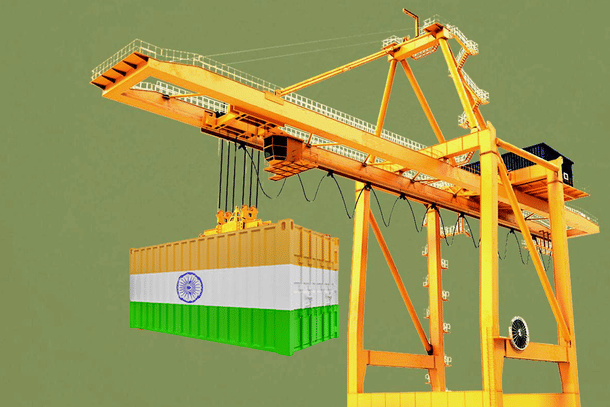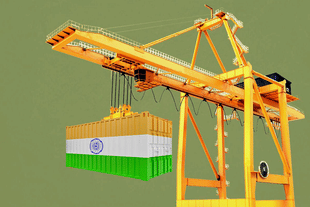Infrastructure
Explained: Why India Is Building A Transshipment Port In Andaman And Nicobar's Galathea Bay
Prakhar Gupta
Sep 07, 2024, 12:07 PM | Updated Sep 13, 2024, 05:36 PM IST
Save & read from anywhere!
Bookmark stories for easy access on any device or the Swarajya app.


The Narendra Modi government has officially designated the international transshipment hub at Galathea Bay in the Andaman and Nicobar Islands as a 'major port'.
This move brings the Rs 44,000-crore mega project under the administrative purview of the Ministry of Ports, Shipping, and Waterways, making it eligible for central funding.
The facility is planned to be built in four phases, with Phase 1 set for completion in 2028, offering a handling capacity of 4 million TEUs (twenty-foot equivalent units). Upon full development by 2058, the port is expected to handle up to 16 million TEUs.
This comes a year after the government invited bids for the transshipment port.
For decades, poor infrastructure at India’s ports, coupled with the lack of deep drafts — depth at the berths and channels, has plagued maritime logistics.
This has begun to change recently, but the lack of a transshipment hub in the country continues to hurt competitiveness.
Almost all major ports on India’s east coast and some on the west coast do not have adequate draft. At most of these ports, the draft ranges between 8 and 12 metres. In comparison, the depth at berth and channels at major international ports ranges between 12 and 20 metres, or even more in some cases.
This imposes a severe restriction on the size of vessels that can come to an Indian port. As a result, relatively small vessels, such as Panamax, with 25,000-to-75,000-tonne cargo intake, have to be deployed at these ports in place of larger vessels, such as Capsize ships, with the capacity to take 165,000 to 180,000 tonnes.
This limitation is becoming increasingly challenging to live with, as the size of vessels around the globe is increasing every few years.
Moving a given cargo or containers in one large vessel is cheaper than moving it in multiple smaller ships as the economy of scale kicks in, especially in the case of freight-sensitive cargo.
Dredging, or the removal of silt and other material from the ocean floor near channels and berths, can help increase the draft and maintain it.
However, this process is costly, especially when employed to increase the draft of a port drastically, and has several other limitations. The other option is transshipment.
Transshipment involves offloading cargo from one ship and loading it onto another vessel to be carried to the final port of discharge.
For transshipment in India’s case, incoming cargo is unloaded from large ships at a transshipment hub and loaded onto smaller ships to be carried to ports that can’t handle large vessels due to low draft.
Outbound cargo from Indian ports that can’t handle large vessels is unloaded from small ships at the transshipment hub and loaded onto larger ships going to the destination port.
In this process, cargo/containers/goods can cover a large part of the distance between the origin and destination ports on a large vessel.
Colombo and Singapore, along with some other major ports in the region, such as Dubai, act as transshipment hubs for cargo headed towards Indian ports.
Nearly 25 per cent of all containers originating from India are transshipped through foreign ports. Around 80 per cent of this is handled by Colombo, Singapore, and Klang (Malaysia), all of which are foreign ports.
This dependence on foreign ports is a disadvantage for two reasons.
One, according to a report on the Ministry of Shipping’s Sagarmala portal, Indian ports lose out on Rs 1,500 crore of potential revenues each year on transshipment handling of cargo either originating or destined for India.
“This translates into an estimated total loss of Rs 3,000-4,500 crore to economy (assuming an economic multiplier of 2-3x for ports). The loss is even higher if opportunity to handle cargo emerging from other countries in the region is considered,” the report on the Sagarmala portal reads.
Transshipment adds to the cost incurred by the Indian industry.
Apart from the cost of the feeder voyage to and from Indian ports to the transshipment hub, which is unavoidable, the cost of handling cargo — loading and unloading — at the hub also gets added to the transshipped cargo.
“...industry estimates put the burden of transshipping through Colombo for Indian shippers at $200 to $250 per container unit on average,” a 2019 report by Bency Mathew of JOC.com, a provider of trade intelligence, says.
In India’s case, this is paid to foreign ports. If transshipment hubs are built in India, much of this will go to Indian ports and result in job creation.
Two, with increasing Chinese influence through massive investment in port infrastructure in the Indian Ocean as part of the Belt and Road Initiative, dependence on foreign ports is a potential national security challenge.
A part of the Colombo port, which has the largest share of the Indian transshipment pie at over 40 per cent, is already run by the Chinese.
Beijing runs the International Container Terminals at the Colombo port, which accounted for 40 per cent of all container traffic in the island country in 2019. It has also invested billions in infrastructure around the port, including new business and residential districts as part of Port City Colombo.
In the midst of its worst economic crisis, Sri Lanka has been forced to grant concessions to China, such as allowing the docking of its intelligence-gathering ships, despite public protests from India. With Colombo increasingly dependent on Beijing for debt relief, the need for New Delhi to reduce this dependence has never been greater.
Therefore, developing a major transshipment hub in India is a necessity.
Galathea Bay of the Great Nicobar Island, where the proposed transshipment hub may come up, has a depth of 18 to 20 metres to handle large ships.
The bay has a rocky floor. This means that the port, Johanan Collins of Western Michigan University and Lieutenant Commander Renjan Oommen write in a paper, “will not require dredging which is a...recurring operating cost (Indian Hydrographic Office, 2014).”
The island straddles the East-West Sea Route, which is one of the busiest maritime trade routes in the world and is located almost equidistant from the existing transshipment hubs of Colombo, Port Klang, and Singapore.
The island lies around 8 nautical miles away from the route. The deviation time for shipping to reach the proposed port, this news report says, “will be less than an hour, while it is four hours to Kochi and eight hours to Thoothukudi.”
Some of the fastest-growing major economies, such as Vietnam, Indonesia, Myanmar, and Bangladesh, are served by the East-West Sea Route.
It sits strategically near the mouth of the Malacca Strait, which links the Indian and Pacific Oceans. Around 100,000 vessels, forming about one-quarter of the world’s traded goods, pass through this narrow stretch of water every year.
The Great Nicobar Island, a geotechnical report on the proposed port published in 2016 said, “forms the ideal site being a nodal point, in the Australia, Japan and Korea navigational route for creating a transhipment port.”
“If India institutes a transshipment terminal at this location world shipping companies would take advantage by cutting short their travel distance to South Bay/Campbell Bay (Great Nicobar island) and other countries will pick-up/dispatch their containers to South Bay/Campbell Bay,” the report, published in a peer reviewed journal, said.
The proposed port can compete with the Port of Singapore for cargo originating and destined for Bangladesh and Myanmar. Currently, nearly 70 per cent of cargo from Bangladesh and Myanmar is transshipped through Singapore.
The Great Nicobar Island is closer to Bangladesh and Myanmar than Singapore, and this factor will reduce the distance to be covered in the feeder voyage to the transshipment hub and, thus, reduce cost.
Prakhar Gupta is a senior editor at Swarajya. He tweets @prakharkgupta.





